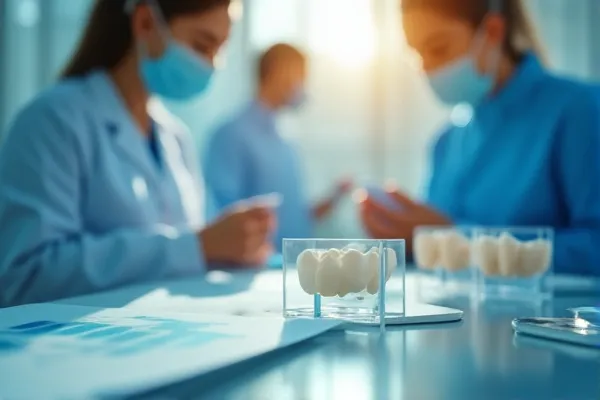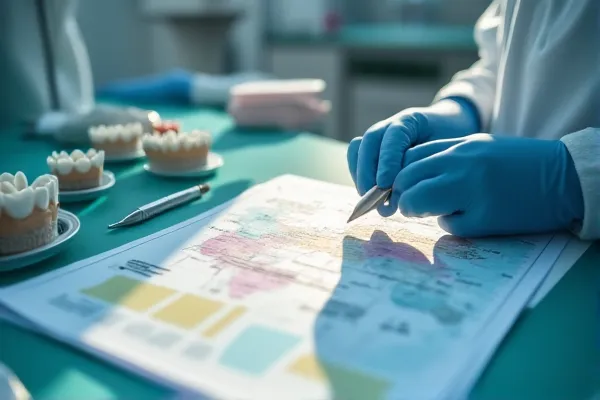Dental crown pricing can be confusing and inconsistent, especially across regions and labs.
Without clarity, clinics may face hidden costs, unpredictable quality, or overpay for subpar restorations.
By understanding key cost drivers—like alloy content, lab model, and long-term value—dental professionals can make informed, cost-effective crown sourcing decisions.
The cost of semi-precious dental crowns typically ranges from $150 to $450 per unit. Pricing is affected by alloy composition, lab location, manufacturing methods, customization level, and delivery logistics, making supplier evaluation essential for accurate budgeting.
What Is the Average Cost of Semi-Precious Dental Crowns?
The average cost of semi-precious dental crowns typically ranges between $150 and $450 per unit, depending on region, lab type, and material composition. Understanding price ranges by geography and lab model helps clinics benchmark and plan effectively.

DentalCrownPricing-GlobalComparison
What Is the Typical Price Range for Semi-Precious Crowns in Different Regions?
Crown pricing varies significantly by region due to labor, logistics, and regulatory factors.
| Region | Price Range (USD per crown) | Notes |
|---|---|---|
| North America | $250–450 | Higher labor and regulatory costs |
| Europe | $200–400 | Price varies with in-house vs. outsourced labs |
| Australia / NZ | $220–420 | Logistics impact costs significantly |
| Middle East | $180–350 | Growing demand, rising local production |
| Southeast Asia | $120–250 | Lower labor cost, often use offshore labs |
| China (for export) | $80–180 | Export-focused pricing, high volume |
How Do Prices Vary Across Different Types of Dental Labs?
Different lab business models offer distinct pricing tiers.
| Lab Type | Average Price Range | Key Characteristics |
|---|---|---|
| In-house dental lab | $300–450 | Onsite convenience, higher overhead |
| Local boutique lab | $250–400 | Personalized service, limited capacity |
| National chain lab | $200–350 | Standardized output, reliable systems |
| Offshore partner lab | $80–200 | Competitive pricing, reliant on logistics |
| Digital-first lab | $180–300 | Optimized workflows, CAD/CAM-driven |
What Factors Cause Cost Differences Between Materials and Manufacturing?
Several technical variables influence the final crown cost.
- Alloy content: Higher noble metal percentages increase cost.
- Casting vs. milling: Digital workflows may reduce labor but require upfront investment.
- Finish level: High-polish and layering add cost for esthetic zones.
- Case complexity: Multiple units or unique anatomies raise design time and QA requirements.
The cost of semi-precious dental crowns depends not just on region, but also on lab model, workflow, and materials used. Clinics evaluating suppliers should request itemized quotes to compare true cost per usable unit.
What Key Factors Influence the Cost of Semi-Precious Dental Crowns?
The cost of semi-precious crowns is shaped by three core elements: alloy composition, lab capabilities, and case complexity. Understanding how each contributes helps clinics choose suppliers with true value—not just low price tags.

DentalCrown-CostFactors-Alloy-Tech-Design
How Does Alloy Composition Affect Crown Pricing?
Alloy content directly impacts cost due to metal type and purity.
- Palladium-rich alloys are pricier but offer high strength and tarnish resistance.
- Nickel-chromium options are more affordable but raise biocompatibility concerns.
- Cobalt-chromium balances cost and mechanical performance.
- Weight-based pricing means larger units or bridges cost more due to higher alloy volume.
How Do Lab Skills and Technology Impact Crown Costs?
A lab’s internal quality determines how much value each crown delivers.
- Advanced CAD/CAM reduces manual error and remake frequency.
- Well-trained technicians ensure contouring, occlusion, and marginal fit are clinically precise.
- Digital workflow integration cuts production lag and improves consistency.
- QA protocols (e.g. scanning, peer checks) add cost but prevent remake-related expenses.
How Do Customization and Design Complexity Affect Pricing?
More complex restorations require more design hours and technical care.
- Multi-unit bridges require longer design and fitting time.
- Anatomical customization (e.g. opposing bite or tight interproximal space) increases labor.
- Layered porcelain or esthetic zones demand higher finishing quality.
- Implant-supported crowns involve components beyond the crown unit.
✅ Material, technique, and design complexity all contribute to pricing – TRUE
Crown cost is a sum of inputs—both physical (metal) and technical (labor, expertise).
❌ All semi-precious crowns cost roughly the same regardless of lab – FALSE
Material grades, digital maturity, and technician skills create wide pricing variation even for “the same crown.”
How Do Location and Lab Reputation Affect the Cost of Semi-Precious Crowns?
Crown pricing is influenced not only by what goes into the product, but also where and by whom it’s made. Lab location affects operational costs, while reputation signals quality, reducing hidden downstream costs like remakes and delays.

DentalLab-CostComparison-LocationReputation
How Does Lab Location—Domestic or Overseas—Affect Crown Cost?
Geography affects labor, shipping, and even regulatory compliance costs.
- Domestic labs generally have higher overhead due to labor and rent.
- Overseas labs (e.g. China, Vietnam) offer lower unit costs due to volume and labor cost advantages.
- Shipping fees and customs delays may offset some savings.
- Time zone differences can affect communication and production alignment.
- Regulatory expectations may differ, affecting traceability and documentation.
How Do Lab Reputation and Experience Influence Crown Pricing?
Established labs often command higher fees—but also deliver fewer surprises.
| Lab Type | Reputation Level | Cost Range | Value Contribution |
|---|---|---|---|
| New / budget lab | Low | $80–150 | Low cost, higher risk |
| Mid-tier local lab | Moderate | $150–250 | Balanced cost and service |
| Established regional lab | High | $200–350 | Lower remake rate, stronger support |
| Specialized expert lab | Premium | $300–450 | Complex cases, esthetic excellence |
How Do Turnaround Time and Delivery Speed Impact the Final Cost?
Speed often requires extra investment—but can save costs chairside.
- Rush production fees are common for <48h dispatch.
- Faster shipping methods (express air) increase cost per unit.
- Efficient labs reduce idle chair time, potentially offsetting crown cost.
- Predictability is key—fast but unreliable labs can still cost more long-term.
Crown pricing is a layered equation: location sets the base cost, while reputation, speed, and support define long-term value. Understanding how each factor plays out helps clinics choose more than just “a cheap crown”—they choose consistency.
How Can Dental Clinics Control the Cost of Semi-Precious Crowns?
Controlling crown costs is not only about negotiating better prices—it’s also about reducing waste, optimizing supplier collaboration, and improving ordering efficiency. Strategic procurement can lower long-term expenses without compromising quality.
Image
ALT: DentalClinic-CostControl-BulkNegotiation
Prompt: A realistic image of a dental clinic manager reviewing bulk order agreements with a dental lab supplier, charts showing order volumes and savings, clean office setting, natural lighting and digital invoice screen.
How Can You Negotiate Better Prices with Labs Through Bulk Orders?
Volume drives value—clinics can unlock better pricing through structured agreements.
- Review your monthly case volume to estimate baseline demand.
- Group orders where possible to exceed lab discount thresholds.
- Request volume-tiered pricing—e.g., 30, 50, 100 units/month.
- Negotiate shipping inclusions on high-volume or scheduled batches.
- Ask for periodic review clauses to adjust terms as volume grows.
How Can the Right Supplier Help Reduce Crown Costs?
A good supplier does more than offer a low unit price—they optimize your workflow.
- Lower remake rates reduce hidden clinical costs and chairside disruption.
- Clear communication saves time and prevents design mismatches.
- Fast support minimizes delays on critical cases.
- Flexible logistics (batch shipping, regional hubs) reduce per-shipment fees.
- Digital tools simplify case uploads, tracking, and invoicing.
How Does Streamlining Ordering and Delivery Help Cut Costs?
Operational efficiency translates into cost savings over time.
- Template-based Rx forms reduce communication loops.
- Online portals allow quicker case submission and real-time status tracking.
- Scheduled pickups or batch shipments consolidate logistics.
- Defined remake processes avoid delays and excess admin handling.
Lowering crown costs isn’t just about negotiating price—it’s about improving systems. To find out how our lab helps clinics reduce real per-unit cost, request a custom volume quote and delivery analysis based on your monthly needs.
What Long-Term Costs Should Clinics Consider When Using Semi-Precious Crowns?
Beyond unit price, clinics should evaluate the total cost of ownership—including remakes, patient callbacks, chair time, and clinical trust. Semi-precious crowns often offer better longevity and lower correction frequency, translating into long-term savings.

DentalCrown-LongTermCost-ROI
What Is the Total Cost of Ownership for Semi-Precious Crowns?
Total cost of ownership (TCO) includes more than just the lab invoice.
| Cost Component | Impact | Notes |
|---|---|---|
| Unit price | Immediate | Varies by lab and material |
| Remake frequency | Medium–high | Each remake adds chair time and admin effort |
| Fit accuracy | High | Poor margins create adjustment time and refits |
| Patient satisfaction | Long-term | Impacts referrals and retention |
| Warranty support | Indirect | Labs with good policies reduce financial risk |
How Do Reduced Maintenance and Fewer Remakes Lower Long-Term Costs?
Well-made semi-precious crowns can minimize long-term clinical and administrative friction.
- Accurate fit leads to shorter chair time and fewer occlusal issues.
- Stable alloys reduce breakage or metal reactions over time.
- High polish surfaces reduce plaque retention and gingival inflammation.
- Lower remake rates cut reappointment scheduling and material wastage.
- Consistent lab quality lowers the need for chairside adjustments.
How Should Clinics Evaluate the ROI of Semi-Precious Crowns?
Return on investment goes beyond price—it’s about time, trust, and consistency.
- Track chair time per case across different labs.
- Monitor remake incidence over a 3–6 month period.
- Calculate lost revenue from canceled or extended appointments.
- Include patient feedback and satisfaction as a soft ROI factor.
- Evaluate clinical predictability as part of overall treatment planning.
✅ Total value includes long-term clinical efficiency and reduced remakes – TRUE
Upfront savings can be misleading if they lead to more rework, patient dissatisfaction, or unplanned chair time.
❌ Initial price is the only factor that matters when choosing crowns – FALSE
Short-term cost cuts often create long-term inefficiencies that reduce clinical profitability.
Conclusion
Understanding semi-precious crown pricing goes beyond comparing lab invoices—it requires a deeper look at alloy quality, production workflows, and long-term clinical value. By aligning cost awareness with quality expectations, dental clinics can make smarter, more sustainable crown sourcing decisions.
- The average price range for semi-precious crowns spans $150–450 depending on region, lab type, and alloy composition.
- Key cost drivers include alloy quality, lab technology, and case complexity, all of which influence labor and material input.
- Location and lab reputation shape both unit cost and downstream reliability, affecting remake rates and delivery timelines.
- Clinics can control crown costs through volume-based agreements, streamlined workflows, and supplier collaboration.
- Evaluating the total long-term cost of crown use helps reduce remakes, protect chair time, and improve patient retention.
- Strategic lab partnerships improve ROI and treatment consistency, ensuring crown performance aligns with clinical goals.
Want a customized breakdown of your lab spend? Request a personalized pricing and ROI report to identify cost-saving opportunities across your restorative workflow.


